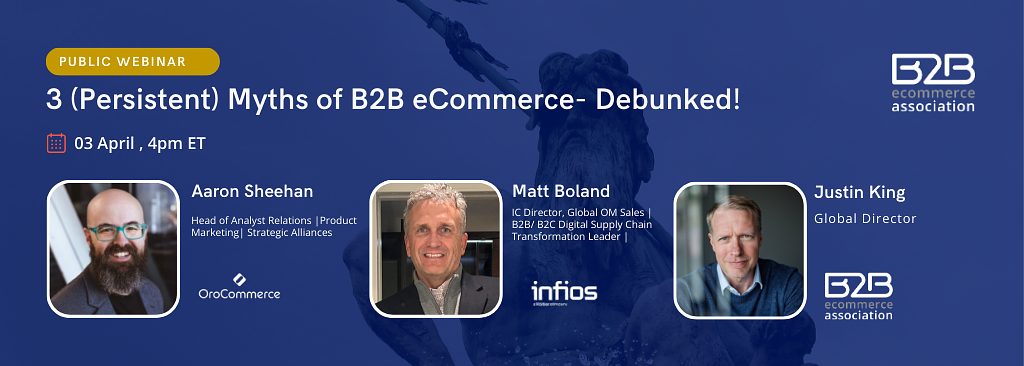For the last decade, “best practices” have ruled the B2B product content world like gospel. But if you’ve been operating under the assumption that mimicking Amazon or following blog-fed standards will give you a competitive edge, it’s time to recalibrate.
That was the message from a game-changing conversation between Justin King and George Koenig—two veterans in the B2B eCommerce space who have finally cracked the code on what makes product content convert in B2B. Spoiler alert: it’s not more of the same.
Why Product Detail Pages Are Finally Getting Their Moment
In B2B, product detail pages (PDPs) haven’t historically gotten the same love they get in retail. Why? Two reasons:
- Platform limitations dictated layout and length.
- “Good enough” content was seen as a cost-saving move, not a conversion tool.
But this view is changing, fast.
George brought forward a study of 10,000 SKUs from a real distributor, analyzing over 720,000 data points tied to actual conversion metrics, not vanity stats. For the first time, we can correlate specific content elements with measurable revenue impact. That’s huge.
Standards Are Dead. Long Live the Cheat Codes.
Here’s what many of us have done for years: applied recycled retail rules like “titles should be 80 characters,” or “use at least three images,” and called it a day.
George’s study reveals that this is not just outdated, it’s holding companies back.
Instead, what emerged were conversion cheat codes: patterns that actually move the needle, but they vary by category, brand, and even distributor.
In other words, your cheat code isn’t your competitor’s cheat code. And that’s exactly why the era of universal PDP standards is over.
What the Data Tells Us About Content That Converts
Let’s break down some of the standout findings from the report and why they matter.
1. Title Length Isn’t Just a Character Count Game
For SKUs with titles under 20 characters, conversion rates were 41% below baseline. SKUs with optimized title lengths? 12% above.
But the real insight here isn’t just “make titles longer.” It’s: make them meaningful.
The optimal title included:
- The full product name
- Key technical specs (voltage, size, amperage, etc.)
- Category-specific attributes
- The product number, which also improved conversions when duplicated in specs
That last point matters: placing important identifiers in multiple content zones led to higher engagement. Think of it as content triangulation.
2. Descriptions Are Underrated (and Misused)
67% of SKUs had opportunities for improvement in their product descriptions. Even a modest 50-character description lifted conversions by 24%.
The kicker? Descriptions that just regurgitated the title or specs had zero added value and were filtered out of the analysis entirely.
Here’s what worked:
- Including dimensions
- Materials
- Use cases
- Application context (e.g., “ideal for low-voltage HVAC systems”)
And this is critical, those elements worked best when repeated in specs and titles. A user scanning a page needs to catch vital info wherever their eye lands.
3. Images Drive Double-Digit Gains
Everyone knows images matter. But this study quantified it.
Going from one image to two? 136% increase in conversion.
George’s takeaway: “Sure, everyone knows more images are better. But no one had the actual conversion delta before.”
Even better: AI can now analyze image types, product-in-use, packaging, close-up, lifestyle and we’re not far from knowing which image types perform best per category.
4. Custom Standards Beat Generic Rules Every Time
The old rule was “follow the standards.”
The new rule? Write your own.
By building a custom scoring system that reflected their actual customers, platforms, and content limitations, the distributor in this study discovered a tailored roadmap to ROI.
They didn’t just improve content, they forecasted the revenue impact of doing so. Some SKUs had 15-20% projected lifts in conversion after optimization.
That’s not “nice to have.” That’s budget-moving material.
Why This Matters for B2B Right Now
Let’s get practical. If you’re a distributor:
- You’ve probably inherited supplier content that’s all over the map.
- Your team is overwhelmed trying to “fix” content without clear direction.
- Your conversion metrics may be skewed by internal usage (hello, sales teams using the webstore to place orders).
George’s approach involves filtering all of that out, removing outliers, segmenting by category, and tying actual performance to each SKU’s content profile.
The result? Distributors can finally prioritize improvements by ROI, not just SKU count or vendor push.
If you’re a manufacturer:
- Your content could make or break how your brand performs on each distributor’s site.
- You may be stuck in a loop of sending the same content to every partner.
- Now, you can tailor content based on real feedback loops.
One distributor in the study planned to share scorecards directly with suppliers, closing the loop and allowing manufacturers to play an active role in optimization.
Want Higher Conversions? Audit First.
Here’s the methodology George used and any B2B company can adapt:
- Audit your current product pages across categories.
- Score each content element (title, description, images, PDFs, specs).
- Map those scores to actual performance metrics (conversion, sales, returns).
- Identify which content attributes correlate to high conversions.
- Build new content standards, by category, not universally.
- Test, refine, repeat.
Yes, this takes effort. But the ROI is real and measurable.
You Can’t Fix What You Can’t See
One of the most repeated takeaways from the discussion was this: content readiness is not content quality.
Just because a title exists in your PIM doesn’t mean it’s doing anything. “T” is a valid field input in some systems. Doesn’t mean it’s helping customers.
Stop checking boxes. Start measuring impact.
What’s Next?
This research is more than just a good idea, it’s a roadmap for the future of B2B eCommerce content strategy.
If you’re serious about scaling your digital business, improving product discoverability, and reducing returns, custom PDP optimization is the next frontier.
And not because it’s trendy. Because it works.
As Justin King put it, “Our job in B2B is to help customers do their job faster, easier, and better.”
Optimizing your product content isn’t about storytelling, it’s about utility. And in B2B, utility wins every time.









